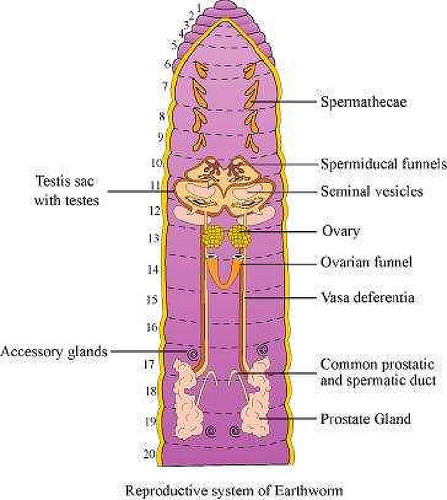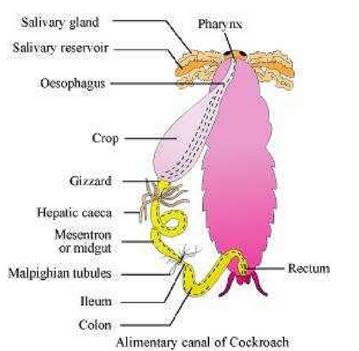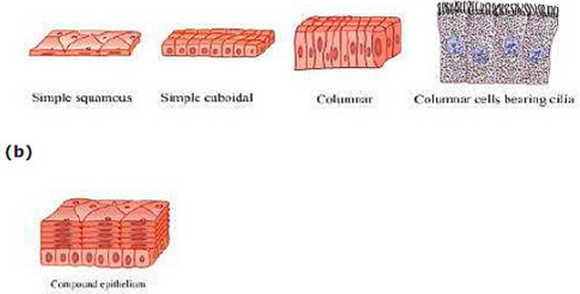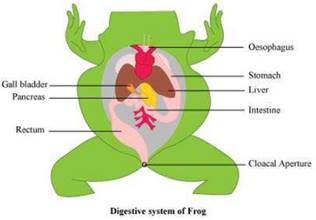Structural Organisation in Animals - Solutions
CBSE Class 11 Biology
NCERT Solutions
Chapter 07
Structural organization in animals
1. Answer in one word or one line.
(i) Give the common name of Periplaneta americana.
(ii) How many spermathecae are found in earthworm?
(iii) What is the position of ovaries in the cockroach?
(iv) How many segments are present in the abdomen of cockroach?
(v) Where do you find malphigian tubules?
Ans. (i) American cockroach.
(ii) Four pairs of spermathecae are present in earthworms.
(iii) A pair of ovaries is located between 12th and 13th abdominal segments.
(iv) Ten segments.
(v) Malphigian tubules are main part of the alimentary canal.
2. Answer the following:
(i) What is the function of nephridia?
(ii) How many types of nephridia are found in earthworm based on their location?
Ans. (i) Nephridia are segmentally arranged excretory organs present in earthworms.
(ii) On the basis of their location, three types of nephridia are found in earthworms. They are:
(a) Septal nephridia: These are present on both sides of the inter-segmental septa behind the 15th segment. They open into the intestines.
(b) Integumentary nephridia: These lie attached to the body wall from the third segment to the last segment, which opens on the body surface.
(c) Pharyngeal nephridia: These are present as three paired tufts in fourth, fifth, and sixth segments.
3. Draw a labelled diagram of the reproductive organs of an earthworm.
Ans.
4. Draw a labelled diagram of alimentary canal of a cockroach.
Ans.
5. Distinguish between the following
(a) Prostomium and peristomium
(b) Septal nephridium and pharyngeal nephridium
Ans. (a)
| Prostomium | Peristomium |
| Prostomium is a small fleshy lobe, which overhangs the mouth of an earthworm. It helps the organism push into the soil and is sensory in function. | The first body segment in the earthworm is called the peristomium. It surrounds the mouth opening. |
(b)
| Septal nephridium | Pharyngeal nephridium |
| They are present on both side of inter-segmental septa behind the 15th segment and they open into the intestine. | They are present as three paired tufts inb the fourth, fifth, and sixth segments. |
6. What are the cellular components of blood?
Ans. Components of blood include erythrocytes (RBCs), leucocytes (WBCs), and thrombocytes (platelets). These components form 45% of blood. They are suspended in the remaining fluid portion, called plasma.
Mammalian erythrocytes are biconcave, coloured cells devoid of a nucleus. They help in transporting respiratory gases.
Leucocytes or white blood cells are nucleated cells. They can be divided into two types, granulocytes (neutrophils, eosinophils, and basophils) and agranulocytes (lymphocytes and monocytes). They help fight against various disease-causing agents entering the body.
Thrombocytes are cell fragments produced from megarkaryocytes of the bone. They play a major role during blood coagulation.
7. What are the following and where do you find them in animal body
(a) Chondriocytes
(b) Axons
(c) Ciliated epithelium
Ans. Chondriocytes:They are cells of cartilages, and are present in small cavities within the matrix secreted by them.
Axons:They are long, slender projections of neurons that help in carrying nerve impulses from the neuron body. Axons aggregate in bundles which make up the nerves.
Ciliated epithelium: It consists of simple columnar or cuboidal epithelium with cilia on their free surfaces. It is present on the inner surface of the oviducts and bronchioles. It helps in the movement of eggs or mucus in specific directions.
8. Describe various types of epithelial tissues with the help of labelled diagrams.
Ans. Epithelial tissue lines the surface of a body and forms a protective covering. Epithelium cells are packed tightly together with little intercellular matrix. Epithelial tissue in the body is of two types.
(a) Simple epithelium: It consists of a single layer of cells where cells are in direct contact with the basement membrane. It is further sub-divided into the following types:
(i) Simple squamous epithelium: It consists of a single layer of flat cells with irregular boundaries. It is found in the walls of the blood vessels and in the lining of alveoli.
(ii) Simple cuboidal epithelium: It consists of a single layer of cube-like cells. It is present in regions where secretion and absorption of substances takes place such as the proximal convoluted tubule region of the nephron.
(iii) Simple columnar epithelium: It consists of a single layer of tall, slender cells with their nuclei present at the base of the cells. They may bear micro-villi on the free surfaces. Columnar epithelium forms the lining of the stomach and intestines, and is involved in the function of secretion and absorption.
(iv) Ciliated epithelium: It consists of columnar or cuboidal cells with cilia on their free surfaces. They are present in bronchioles and oviducts from where they direct mucus and eggs in specific directions.
(v) Glandular epithelium:It consists of columnar or cuboidal cells involved in the secretion of substances. Glands are of two types, unicellular glands (goblet cells of the alimentary canal) and multicellular glands (salivary glands). They can be classified as exocrine (ductless glands) and endocrine glands (duct glands) by the method through which they release enzymes.

Compound epithelium: It consists of many layers of cells. It is involved mainly in the function of providing protection and has a limited role in secretion and absorption. Examples of compound epithelium include the dry surface of the skin or moist inner lining of the buccal cavity, pharynx, pancreatic ducts, and the inner lining of ducts of salivary glands.
9. Distinguish between
(a) Simple epithelium and compound epithelium.
(b) Cardiac muscle and striated muscle
(c) Dense regular and dense irregular connective tissues
(d) Adipose and blood tissue
(e) Simple gland and compound gland
Ans.
a) Simple epithelium and compound epithelium
Simple Epithelium | Compound Epithelium |
i. It is only one cell deep. ii. All cells rest on the basement membrane. iii. It provides poor protection to underlying tissues. iv. It plays a role in absorption, secretion and excretion. | i. It is many cells deep. ii. Only cells of the lowermost layer rest on the basement membrane. iii. It provides much better protection to underlying tissues. iv. It has little role in absorption, secretion and excretion. |
b) Cardiac muscle and striated muscle
Cardiac Muscle | Striated Muscle |
i. It occurs in the walls of the heart, pulmonary veins and superior vena cava. ii. Fibres are branched. iii. It is uninucleated. iv. It never gets fatigued. v. It is an involuntary muscle. | i. It occurs in the limbs, body walls, tongue, pharynx and beginning of oesophagus. ii. Fibres are unbranched. iii. It is multinucleated. iv. It soon gets fatigued. v. It is a voluntary muscle. |
c) Dense regular connective tissue and dense irregular connective tissue
Dense regular connective tissue | Dense irregular connective tissue |
i. It has a regular pattern of fibres. ii. The collagen fibres are present in rows between many parallel bundles of fibres. Examples: Tendon and ligament | i. It has an irregular pattern of fibres. ii. It has fibroblasts and many fibres (mostly collagen) which are oriented differently. Example: Skin |
d) Adipose and blood tissues
Adipose tissue | Blood tissue |
i. Adipose tissue is a type of loose connective tissue located mainly beneath the skin. ii. Its main function is to store fat. The excess of nutrients which are not used immediately are converted into fats and are stored in this tissue. | i. Blood is a fluid connective tissue. ii. The main function of blood is to transport gases, nutrients and waste products in the body. |
e) Simple gland and compound gland
Simple gland | Compound gland |
i. It is composed of a single cell. ii. Its secretory part opens into a single duct. | i. It is composed of multiple cells. ii. It has many secretory parts, the ducts of which join to form ducts of higher order and finally a single duct. |
10. Mark the odd one in each series:
(a) Areolar tissue; blood; neuron; tendon
(b) RBC; WBC; platelets; cartilage
(c) Exocrine; endocrine; salivary gland; ligament
(d) Maxilla; mandible; labrum; antennae
(e) Prothorax; mesothorax; metathorax; coxa
Ans. (a) Areolar tissue, blood, and tendons are examples of connective tissues. Neuron is an example of neural tissue.
(b) RBCs, WBCs, and platelets are the three most important components of blood. Cartilage is therefore, the odd one out.
(c) Exocrine, endocrine, and salivary glands are examples of simple glandular epithelium. Ligament is a connective tissue.
(d) Maxilla, mandible, and labrum are mouthparts of a cockroach. Antennae, on the other hand, are present in the head region of cockroaches.
(e) Protonema forms the developmental stage in the life cycle of a moss. Mesothorax, metathorax, and coxa are parts or segments present in the legs of a cockroach.
11. Match the terms in column I with those in column II:
Column I | Column II |
a)Compound epithelium | i.Alimentary canal |
b)Compound eye | ii.Cockroach |
c)Septal nephridia | iii.Skin |
d)Open circulatory system | iv.Mosaic vision |
e)Typhlosole | v.Earthworm |
f)Osteocytes | vi.Phallomere |
g)Genitalia | vii.Bone |
Ans. (a)-(iii); (b)-(iv); (c)-(v); (d)-(ii); (e)-(i); (f)-(vii); (g)-(vi)
12. Mention briefly about the circulatory system of earthworm.
Ans. Earthworms have closed blood vascular systems, which consists of the heart, blood vessels, and capillaries. The heart pumps blood for circulating it in one direction. Blood is supplied by smaller blood cells to the gut nerve cord and the body wall. Blood glands are present in the 4th, 5th, and 6th segments, which produce blood cells and haemoglobin dissolved in blood plasma. Blood cells in earthworms are phagocytic in nature.

13. Mention the function of the following
(a) Ureters in frog
(b) Malpighian tubules
(c) Body wall in earthworm
Ans. (a) Ureters in frogs: A ureter acts as a urinogenital duct, which carries sperms along with urine in male frogs.
(b) Malphigian tubules: Malphigian tubules are excretory organs in cockroaches.
(c) Body wall in earthworms: In earthworms, the body wall consists of muscle layers. It helps in movement and burrowing.